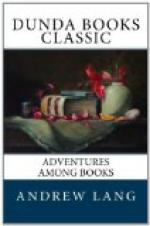He set himself to write Romance, with a definite idea of what Romance-writing should be; “to dream strange things, and make them look like truth.” Nothing can be more remote from the modern system of reporting commonplace things, in the hope that they will read like truth. As all painters must do, according to good traditions, he selected a subject, and then placed it in a deliberately arranged light—not in the full glare of the noonday sun, and in the disturbances of wind, and weather, and cloud. Moonshine filling a familiar chamber, and making it unfamiliar, moonshine mixed with the “faint ruddiness on walls and ceiling” of fire, was the light, or a clear brown twilight was the light by which he chose to work. So he tells us in the preface to “The Scarlet Letter.” The room could be filled with the ghosts of old dwellers in it; faint, yet distinct, all the life that had passed through it came back, and spoke with him, and inspired him. He kept his eyes on these figures, tangled in some rare knot of Fate, and of Desire: these he painted, not attending much to the bustle of existence that surrounded them, not permitting superfluous elements to mingle with them, and to distract him.
The method of Hawthorne can be more easily traced than that of most artists as great as himself. Pope’s brilliant passages and disconnected trains of thought are explained when we remember that “paper-sparing,” as he says, he wrote two, or four, or six couplets on odd, stray bits of casual writing material. These he had to join together, somehow, and between his “Orient Pearls at Random Strung” there is occasionally “too much string,” as Dickens once said on another opportunity. Hawthorne’s method is revealed in his published note-books. In these he jotted the germ of an idea, the first notion of a singular, perhaps supernatural moral situation. Many of these he never used at all, on others he would dream, and dream, till the persons in the situations became characters, and the thing was evolved into a story. Thus he may have invented such a problem as this: “The effect of a great, sudden sin on a simple and joyous nature,” and thence came all the substance of “The Marble Faun” ("Transformation"). The original and germinal idea would naturally divide itself into another, as the protozoa reproduce themselves. Another idea was the effect of nearness to the great crime on a pure and spotless nature: hence the character of Hilda. In the preface to “The Scarlet Letter,” Hawthorne shows us how he tried, by reflection and dream, to warm the vague persons of the first mere notion or hint into such life as characters in romance inherit. While he was in the Civil Service of his country, in the Custom House at Salem, he could not do this; he needed freedom. He was dismissed by political opponents from office, and instantly he was himself again, and wrote his most popular and, perhaps, his best book. The evolution of his work was from the prime notion (which




